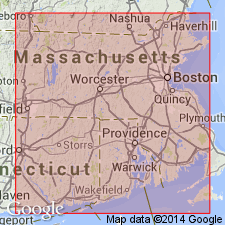
- Usage in publication:
-
- Cowesett Granite
- Modifications:
-
- Revised
- Overview
- Dominant lithology:
-
- Granite
- AAPG geologic province:
-
- New England province
Summary:
Devonian alkalic intrusions, including the well known Scituate Granite, are here grouped under the term Scituate Plutonic Supersuite. Includes all of the recognized Devonian units of alkaline affinity in RI. These are the Scituate Plutonic Suite, the East Greenwich Plutonic Suite, and the Rhode Island Quincy Granite. These alkalic intrusions have an areal extent of 700 square km. The Scituate Plutonic Suite [also called Scituate Granite] consists predominantly of slightly foliated and lineated rocks, though massive and porphyritic rocks are common. Intrudes rocks of the Blackstone Group and the Esmond Granite. Scituate and East Greenwich Plutonic Suites appear to be a congenetic igneous complex based on similar age and mineral assemblages. East Greenwich includes the Spencer Hill Volcanics, the Maskerchugg "Granite," and the Cowesett Granite, the most extensively exposed. Maskerchugg was shown by Jordan (1983: M.S. thesis, Univ. of RI) to be a volcanic unit rather than a granite, hence the quotes. The Cowesett has been dated by Hermes and others (1981) at 373+/-7 Ma. [The usages of Scituate in this report are not recommended. According to Article 41 of the NASC, "the geographic name of a suite may not be the same as that of a component lithodeme. Intrusive assemblages, however, may share the same geographic name if an intrusive lithodeme is representative of the suite." Unit name in this report is misspelled Cowesset.]
Source: GNU records (USGS DDS-6; Reston GNULEX).
For more information, please contact Nancy Stamm, Geologic Names Committee Secretary.
Asterisk (*) indicates published by U.S. Geological Survey authors.
"No current usage" (†) implies that a name has been abandoned or has fallen into disuse. Former usage and, if known, replacement name given in parentheses ( ).
Slash (/) indicates name conflicts with nomenclatural guidelines (CSN, 1933; ACSN, 1961, 1970; NACSN, 1983, 2005, 2021). May be explained within brackets ([ ]).

